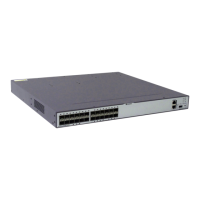4. Run:
isis ipv6 enable [ process-id ]
An IS-IS interface is configured.
After this command is run, the IS-IS device uses the specified interface to send Hello
packets and flood LSPs.
NOTE
No neighbor relationship needs to be established between loopback interfaces. Therefore, if
this command is run on a loopback interface, the routes of the network segment where the
loopback interface resides will be advertised through other IS-IS interfaces.
l (Optional) Configure the level of an IS-IS interface.
1. Run:
system-view
The system view is displayed.
2. Run:
interface interface-type interface-number
The interface view is displayed.
3. Run:
isis circuit-level [ level-1 | level-1-2 | level-2 ]
The level of the interface is configured.
By default, the level of an interface is level-1-2.
NOTE
Changing the level of an IS-IS interface is valid only when the level of the IS-IS device is
Level-1-2. If the level of the IS-IS device is not a Level-1-2, the level of the IS-IS device
determines the level of the adjacency to be established.
l (Optional) Suppress an IS-IS interface.
1. Run:
system-view
The system view is displayed.
2. Run:
interface interface-type interface-number
The interface view is displayed.
3. Run:
isis silent
The IS-IS interface is suppressed.
A suppressed IS-IS interface does not send or receive IS-IS packets. The routes of the
network segment where the interface resides, however, can still be advertised to other
routers within the area.
----End
6.11.4 (Optional) Configuring the IPv6 IS-IS Interfaces
Configuring the IS-IS interface costs can control IS-IS route selection.
S6700 Series Ethernet Switches
Configuration Guide - IP Routing 6 IS-IS Configuration
Issue 01 (2012-03-15) Huawei Proprietary and Confidential
Copyright © Huawei Technologies Co., Ltd.
288

